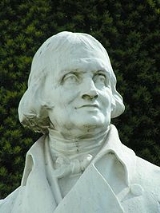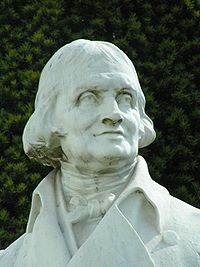
Christophe-Philippe Oberkampf
Encyclopedia
Christophe-Philippe Oberkampf (11 June 1738 – 6 October 1815) was a French naturalized German industrialist. He became famous for founding the royal manufacture of printed cottons of Jouy-en-Josas
where the toile de Jouy
was manufactured.
 Oberkampf was born in Wiesenbach
Oberkampf was born in Wiesenbach
, Germany, into a family of dyers. He traveled to educate himself and initially worked in Mulhouse
as an engraver, then from October 1758 in Paris as a colourist.
In 1770, Oberkampf who had then lived in France for ten years, was made a naturalised French citizen, along with his brother. Around this period, an important technical evolution enabled his company to considerably increase its production: the wooden boards were replaced with copper plates, also engraved, but flexible and able to be fixed on cylindrical drums. The company entered the era of mechanisation.
the title of "royal manufacturer" and in 1787, Oberkampf received from the king the title of squire
as well as the right to use arms and his device "Recte et vigilanter (uprightness and vigilance)".
In 1785 Oberkampf invented the first machine for printing wallpaper, and shortly afterwards, Nicolas-Louis Robert
designed a process for manufacturing endless rolls of wall-paper.
On February 7, 1790, the reforms of the French Revolution
led him to be appointed mayor of Jouy-en-Josas. In 1794 his daughter Émilie was born. Influenced by the British Infant Schools, she would become the pioneer of the nursery school
.
The factory continued to flourish during the Revolution and became the second company of the kingdom after the mirror manufacture of Saint-Gobain. In 1799, sales declined and the manpower - which had reached 2,000 workers - was reduced.
for its eminent role in the manufacture of painted Toile
s. On June 20, 1806, after visiting the workshops, Napoleon, awarded him the legion of honor.
Decrease in the demand and competition got more insistent. In 1815, manpower fell to 435, and the manufacture was closed during the invasion of the armies united against the Emperor.
(today in Yvelines
), his son Emile succeeded him as the head of the company. Taken over by Jacques-Juste Barbet de Jouy in 1822, it finally went bankrupt in 1843.
Oberkampf was buried in the garden of his house, which today houses the Music Academy of Jouy-in-Josas.
Oberkampf's name was given to a Rue Oberkampf
in XIth district of Paris, and to the Oberkampf subway
station that serves it.
Jouy-en-Josas
Jouy-en-Josas is a commune in the Yvelines department in the Île-de-France region in north-central France. It is located in the south-western suburbs of Paris from the center.Jouy-en-Josas is home to the prestigious HEC School of Management.-Geography:...
where the toile de Jouy
Toile
Toile is the name of a fabric that entered the English language around the 16th century from a French word meaning "linen cloth" or "canvas" — particularly cloth or canvas for painting on...
was manufactured.

Wiesenbach, Bavaria
Wiesenbach is a municipality in the district of Günzburg in Bavaria in Germany....
, Germany, into a family of dyers. He traveled to educate himself and initially worked in Mulhouse
Mulhouse
Mulhouse |mill]] hamlet) is a city and commune in eastern France, close to the Swiss and German borders. With a population of 110,514 and 278,206 inhabitants in the metropolitan area in 2006, it is the largest city in the Haut-Rhin département, and the second largest in the Alsace region after...
as an engraver, then from October 1758 in Paris as a colourist.
1759-1700's
In 1759, Oberkampf proposed a partnership with the Swiss for the creation of a manufacture of cottons printed with engraved wood boards in Jouy-in-Josas. The first fabrics were successfully printed in May 1760. In 1764, Oberkampf increased his factory to a vast area of 18,000 m². The number of employees grew quickly and reached 900 workmen in 1774.In 1770, Oberkampf who had then lived in France for ten years, was made a naturalised French citizen, along with his brother. Around this period, an important technical evolution enabled his company to considerably increase its production: the wooden boards were replaced with copper plates, also engraved, but flexible and able to be fixed on cylindrical drums. The company entered the era of mechanisation.
1780's-1790's
In 1783, the factory received from king Louis XVI of FranceLouis XVI of France
Louis XVI was a Bourbon monarch who ruled as King of France and Navarre until 1791, and then as King of the French from 1791 to 1792, before being executed in 1793....
the title of "royal manufacturer" and in 1787, Oberkampf received from the king the title of squire
Squire
The English word squire is a shortened version of the word Esquire, from the Old French , itself derived from the Late Latin , in medieval or Old English a scutifer. The Classical Latin equivalent was , "arms bearer"...
as well as the right to use arms and his device "Recte et vigilanter (uprightness and vigilance)".
In 1785 Oberkampf invented the first machine for printing wallpaper, and shortly afterwards, Nicolas-Louis Robert
Robert brothers
Les Frères Robert were two French brothers. Anne-Jean Robert , and Nicolas-Louis Robert , The brothers were the engineers who built the world's first hydrogen balloon for professor Jacques Charles; it flew from central Paris on...
designed a process for manufacturing endless rolls of wall-paper.
On February 7, 1790, the reforms of the French Revolution
French Revolution
The French Revolution , sometimes distinguished as the 'Great French Revolution' , was a period of radical social and political upheaval in France and Europe. The absolute monarchy that had ruled France for centuries collapsed in three years...
led him to be appointed mayor of Jouy-en-Josas. In 1794 his daughter Émilie was born. Influenced by the British Infant Schools, she would become the pioneer of the nursery school
Nursery school
A nursery school is a school for children between the ages of one and five years, staffed by suitably qualified and other professionals who encourage and supervise educational play rather than simply providing childcare...
.
The factory continued to flourish during the Revolution and became the second company of the kingdom after the mirror manufacture of Saint-Gobain. In 1799, sales declined and the manpower - which had reached 2,000 workers - was reduced.
1800's
In 1806, Oberkampf won a gold medal at the industrial fair of the LouvreLouvre
The Musée du Louvre – in English, the Louvre Museum or simply the Louvre – is one of the world's largest museums, the most visited art museum in the world and a historic monument. A central landmark of Paris, it is located on the Right Bank of the Seine in the 1st arrondissement...
for its eminent role in the manufacture of painted Toile
Toile
Toile is the name of a fabric that entered the English language around the 16th century from a French word meaning "linen cloth" or "canvas" — particularly cloth or canvas for painting on...
s. On June 20, 1806, after visiting the workshops, Napoleon, awarded him the legion of honor.
Decrease in the demand and competition got more insistent. In 1815, manpower fell to 435, and the manufacture was closed during the invasion of the armies united against the Emperor.
Death
When Oberkampf died in 1815 in Jouy-en-JosasJouy-en-Josas
Jouy-en-Josas is a commune in the Yvelines department in the Île-de-France region in north-central France. It is located in the south-western suburbs of Paris from the center.Jouy-en-Josas is home to the prestigious HEC School of Management.-Geography:...
(today in Yvelines
Yvelines
Yvelines is a French department in the region of Île-de-France.-History:Yvelines was created from the western part of the defunct department of Seine-et-Oise on 1 January 1968 in accordance with a law passed on 10 January 1964 and a décret d'application from 26 February 1965.It gained the...
), his son Emile succeeded him as the head of the company. Taken over by Jacques-Juste Barbet de Jouy in 1822, it finally went bankrupt in 1843.
Oberkampf was buried in the garden of his house, which today houses the Music Academy of Jouy-in-Josas.
Oberkampf's name was given to a Rue Oberkampf
Rue Oberkampf
Rue Oberkampf is a street in the 11th arrondissement of Paris. It is named for Christophe-Philippe Oberkampf, an 18th-century German-born French industrialist....
in XIth district of Paris, and to the Oberkampf subway
Oberkampf (Paris Metro)
Oberkampf is a station of the Paris Métro, serving Line 5 and Line 9.The station was opened on 15 January 1907, a month after the opening of the extension of line 5 from Quai de la Rapée to Lancry on 17 December 1906...
station that serves it.
Read also
- Stanley D Chapman; Serge Chassagne ; European textile printers in the eighteenth century : a study of Peel and Oberkampf ; London : Heinemann Educational : Pasold Fund, 1981.
- Josette Brédif; Musée Oberkampf ; Christophe-Philippe Oberkampf et le manufacture de Jouy-en-Josas : historique. ; Jouy-en-Josas, France : Musée Oberkampf, 1987.

